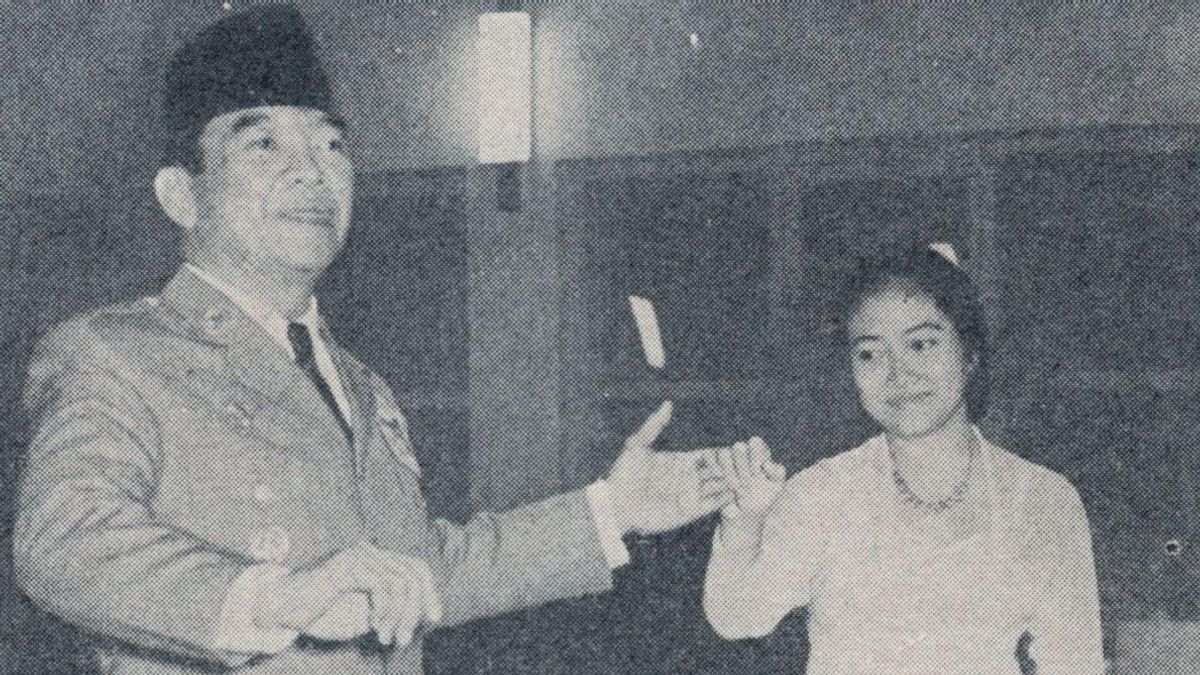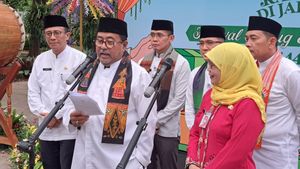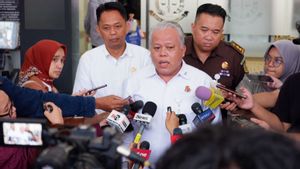JAKARTA - The 19th Republic of Indonesia (RI) Independence Day ceremony in 1964 was a special moment for the Soekarno family. Big Bung acted as the leader of the ceremony. He also delivered the famous state address "The Year of the Vivere Pericoloso." His daughter, Megawati Soekarnoputri, was assigned as one of the Pusaka Flag-Raising Troops (Paskibraka). In particular, the 'Red and White' heirloom flag that was flown was hand stitched by his mother, Fatmawati.
Politics is definitely not a new world for a woman whose full name is Dyah Permata Megawati Setiawati Soekarnoputri. The political teacher himself has no opponent. None other than his own father, the Commander of the Indonesian Revolution, Soekarno. Whenever she had the opportunity to be with her father, Megawati actively asked questions and learned many things.
All because since his mother, Fatmawati left the palace in 1957, the moment of togetherness between father and son has increased. Megawati often accompanied Bung Karno in formal state events, from art events to ceremonies commemorating Indonesian Independence. At the Indonesian independence ceremony on August 17, 1964, for example. Megawati came not only with the frills of the president's son.

Mega involved himself as part of Paskibraka. Megawati was then given the task of raising and lowering the heritage flag. The flag was sewn by his mother, Fatmawati. And his father, Soekarno himself, handed over the flag to Megawati.
"I'm actually retired (Paskibraka) too. Because I used to be like you. The bearer of the heirloom flag. At that time, Alhamdulillah (the heirloom flag) was still original. I brought it, "said Megawati when giving a briefing to the retired Pancasila Ambassadors in Merdeka Palace, Wednesday, August 18.
Story about Sang SakaThe presence of the original heritage flag not only added to the solemnity of the 19th RI independence ceremony. The presence of the heirloom flag reminds us of the role of Megawati's mother, Fatmawati, who sewed the heritage flag during the Japanese occupation. The flag was sewn by Fatmawati herself in October 1944 or two weeks before the birth of her eldest son, Guntur Soekarnoputra.
But it is not an easy matter to sew the Red-White flag. Ibu Fat – Fatmawati's nickname – had a hard time finding cloth for the Red-White flag. The condition of Jakarta, which was hit by the crisis, became the estuary. Fabric raw materials are becoming scarce. On the advice of Bung Karno, Ibu Fat was asked to seek help. Not long after, Ibu Fat called a young man named Chairul Saleh. Fat's mother asked him to meet one of the Japanese dignitaries who was pro-Indonesian struggle, Shimizu.
“Actually, Shimizu really respects the struggle of the Indonesian people. That's why Shimizu felt comfortable when he had to listen to the voices, thoughts, and also the stance of the Indonesian people at that time. What's more, at that time the Indonesian people already considered Shimizu as a close friend. Through this Shimizu, Fatmawati hopes to get a piece of cloth that she can use to sew the flag (when imported goods were already controlled by the Dutch),” said Abraham Panumbangan in the book The Uncensored of Bung Karno (2016).

Fatmawati's decision to ask Shimizu for help was the right decision. Shimizu was actually able to persuade another Japanese dignitary who headed the warehouse in the Watergate area (in front of the former Capitol cinema) to provide the requested fabric.
Thanks to him, Fatmawati also managed to get a cloth to become an heirloom flag. Then, Fatmawati made a flag measuring 2x3 meters. The flag was then flown for the first time on the day of the Proclamation of Independence of the Republic of Indonesia, August 17, 1945. After that, the flag was only flown at every Indonesian independence commemoration ceremony from 1946-1968.
"When I was about to step out of the door I heard a scream that the flag wasn't there yet, then I turned to take the flag I made when Thunder was still in the womb, a year and a half ago. The flag will be given to one of the people present at the place in front of my bedroom. It seems to me that among them are Mas Diro, (Sudiro ex Mayor of Jakarta), Suhud, Colonel Latief Hendraningrat. Immediately we headed to the ceremony venue, Bung Karno in the front, followed by Bung Hatta, then me," said Fatmawati in her book A Little Note with Bung Karno (2016).
Famous speech “Year of Vivere Pericoloso”
No less interesting than Megawati's presence and the heirloom flag that was sewn by his wife. Bung Karno also appeared as the star of the celebration of the 19th Indonesian independence in 1964. His state speech entitled The Year of Vivere Pericoloso is known as one of the best speeches from the Son of the Dawn. Moreover, Bung Karno at that time became the first Indonesian to popularize the term Vivere Pericoloso. The term was taken from Italian: Vivere which means life. While Pericoloso means dangerous. In a sense, living in a year full of dangers.
The speech was deliberately made by Bung Karno because of the complicated political conditions in Indonesia. Not to mention the economic problems that began to move towards the brink of recession. Therefore, with great courage Bung Karno invited all Indonesian people to inflame the spirit of revolution. The spirit to dare to go out and fight various multidimensional crises. Whether it's a political crisis, an economic crisis, to an identity crisis. Everything is so that Indonesia rises up and the dream of becoming a great nation is not just wishful thinking.
“No revolution can be truly violent, if the people do not carry out the revolution with the notion of romance. No Revolution can defend its soul, if its People cannot accept the enemy's attack as the romance of the Revolution, and repel the enemy's attack and crush the enemy as the romance of the Revolution. No revolution can keep its head up, if the people are not ready to carry out the necessary sacrifices, with their heads held high, even with a smiling mouth, because they consider the victims to be the romantics of the Revolution," Bung Karno said in his State of the Union address on August 17, 1964.
Bung Karno did not forget to remind that revolution is a process. Can be achieved quickly or directly. The same goes for the dynamics. It can go up or down. Therefore, moving one rhythm is the solution: the rhythm of revolution.
The speech then amazed many people with the figure of Bung Karno. Even the admiration will grow even more when, towards the end of Bung Karno's speech, the Indonesian people's spirit against imperialism is ignited by shouting "This is my chest, where is your chest!"
“The title of Bung Karno's speech inspired Christopher Koch, an Australian writer, to write a novel entitled 'The Year of Living Dangerously' which was published in 1978. This novel takes the background of the situation in Jakarta in 1965, before and during the events of the Indonesian Movement. September 30, 1965. In 1982, an Australian film with the same title was made, starring famous artists such as Mel Gibson, Sigourney Weaver, and Linda Hunt,” concluded Rhien Soemohadiwidjojo in Bung Karno's book Singa Podium (2013).
*Read other information about SOEKARNO or read other interesting articles from Detha Arya Tifada.
Other MEMORIESThe English, Chinese, Japanese, Arabic, and French versions are automatically generated by the AI. So there may still be inaccuracies in translating, please always see Indonesian as our main language. (system supported by DigitalSiber.id)










